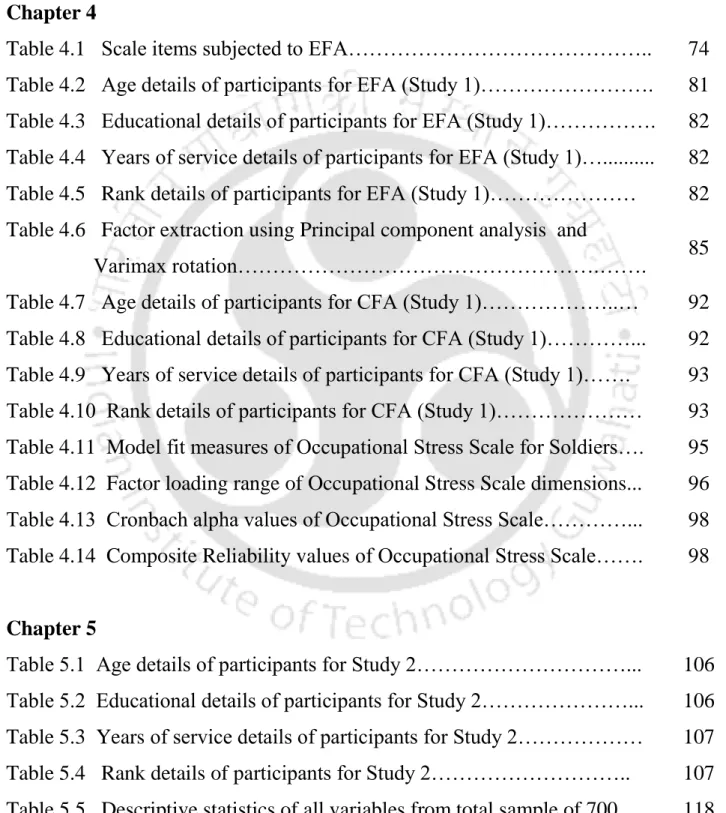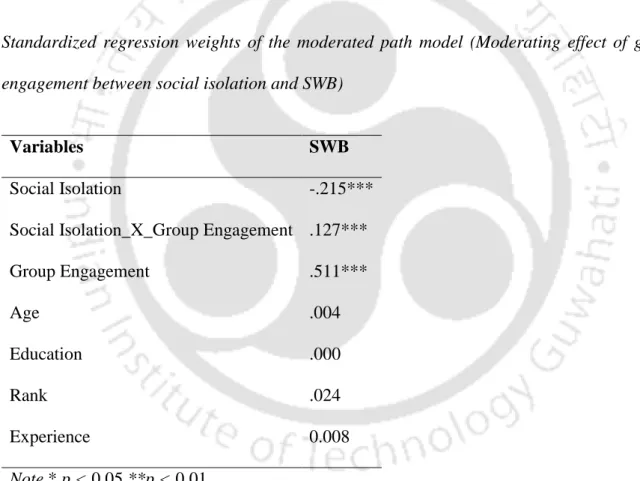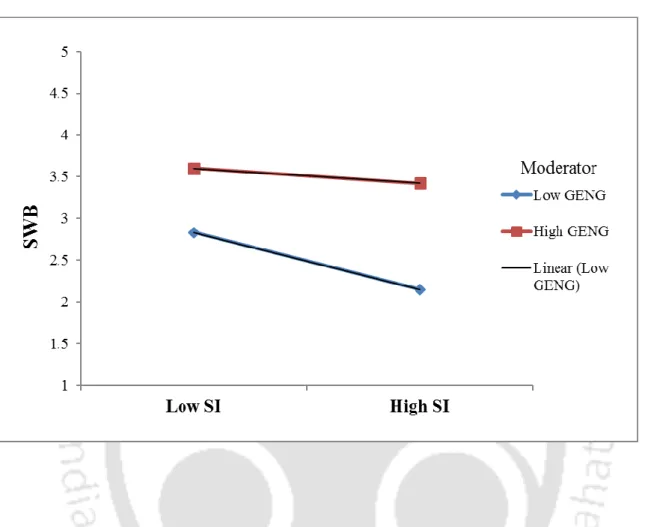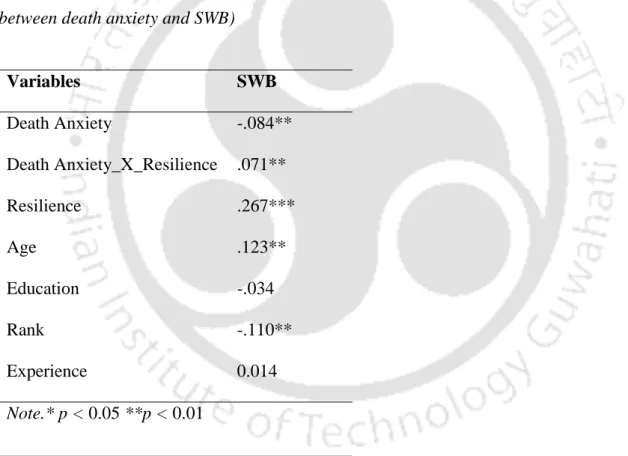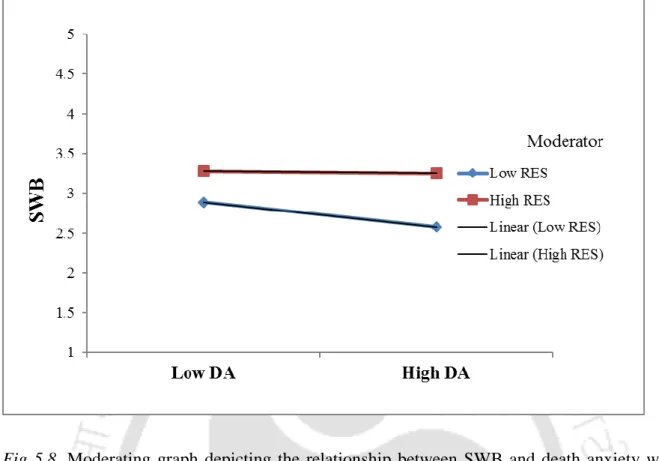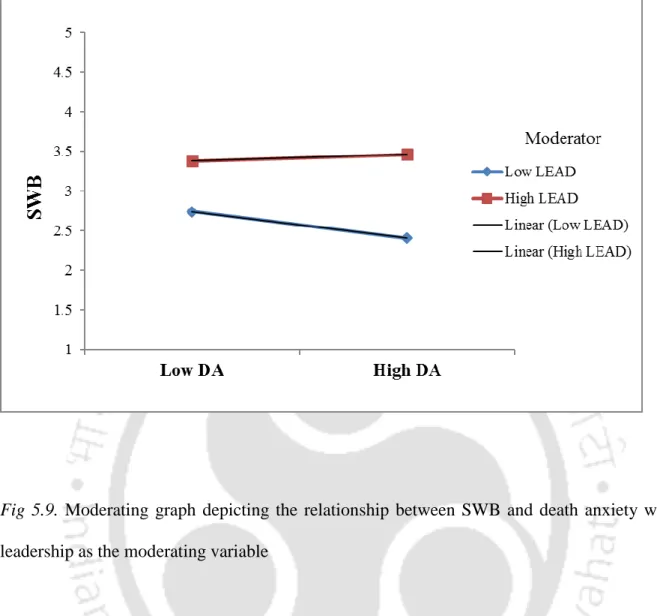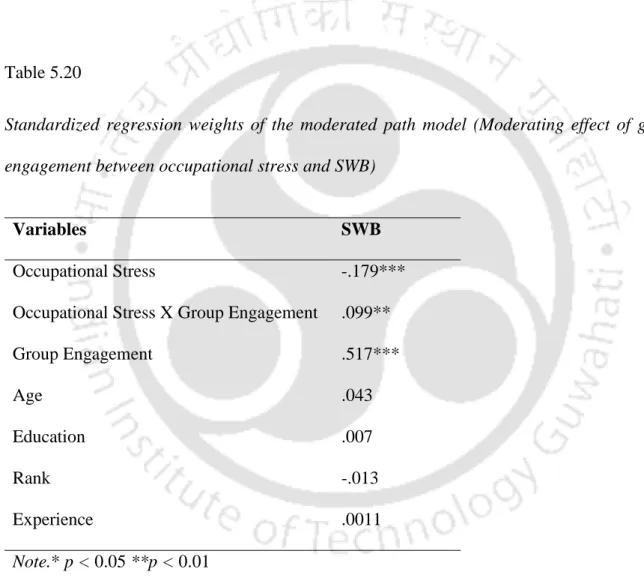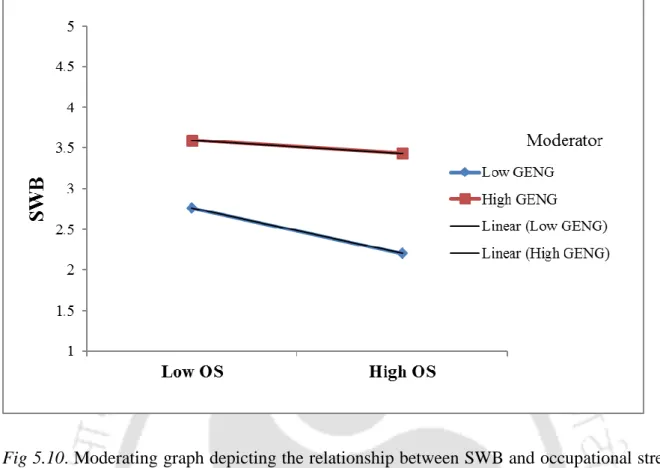This is to prove that the work included in the thesis titled "A Framework of Risk and Protective Factors for the Subjective and Psychological Well-Being of the Indian Army Soldier", by Ms. In study 2, path analysis was conducted to explore the role of risk and protective factors in subjective and psychological well-being.
Research Objectives
Development and validation of Occupational Stress Scale for Soldiers (OSSS)
This prompts the researcher to think clearly about the content of the scale (Slavek & Drnovsek, 2012). The last step was to evaluate the discriminant validity of the scale, which is represented as the Maximum Common Variance (MSV).
Test of proposed theoretical models of soldier well-being
The effect of this on the soldiers' subjective and psychological well-being was studied, making them the dependent variables in this model. The effect of this on the soldiers' subjective and psychological well-being was studied, making them the dependent variables in this study.
Research Questions and Hypotheses
H8: Resilience will moderate the relationship between the risk factors (social isolation, work stress and death anxiety) and both SWB and PWB. H10: Group cohesion will moderate the relationship between the risk factors (social isolation, work stress and death anxiety) and both SWB and PWB.
Results
In other words, resilience helps reduce the negative impact of death anxiety on soldiers' SWB. In other words, leadership helps reduce the negative effect of death anxiety on soldiers' SWB.
Summary results of hypotheses testing
Conclusion and Contributions
Contents
Development and Preliminary Validation of Occupational Stress Scale for Soldiers (Study 1)
Test of Proposed Theoretical Models for Soldier Well-being (Study 2)
List of Tables
List of Abbreviations COAS – Chief of Army Staff
Introduction
Background
OR starts at soldier rank and moves up to Lance Naik (L/Nk), Naik (Nk) and goes up to Havaldar (Sea). Junior officers up to the rank of Major also perform the duties of the Junior Leaders who help train their JCOs and ORs and keep them combat ready at all times.
Occupational stress and well-being of soldiers
The rapid change in society has also led to significant upheavals in the soldier's life. This hesitation is due to a distrust of the effectiveness of mental health treatments and a fear of the consequences.
Measurement of occupational stress among soldiers
Factors influencing Subjective and Psychological well-being of soldiers
Psychological well-being (PWB), or the eudaimonic conception of well-being, calls for people to live up to their daimon or true self (Waterman, 1993). Risk factors for soldiers' well-being included in the study are: (1) Social isolation. 2) Occupational stress and (3) Fear of death.
Rationale for Study 1
Study 1 focuses on the development and validation of an Occupational Stress Scale for Soldiers (OSSS). Study 2 focuses on testing the three proposed theoretical models for soldiers' well-being, including a risk factor model, protective factor model and a moderator factor model, where protective factors are conceptualized as moderators between risk factors and well-being measurements.
Rationale for Study 2
Therefore, it is necessary to explore these variables in the context of soldier's life to understand their role in welfare. Furthermore, empirical studies of soldiers' subjective and psychological well-being are negligible especially in the Indian context.
Review of Literature
The concept of Well-being
The measures of SWB therefore include life evaluation (a reflective assessment of a person's life or some aspect of it) and affect (a person's feelings or emotional states, typically measured with reference to a particular point in time). Therefore, the study will examine the concept of Subjective and Psychological well-being in relation to specific variables that form an integral part of a soldier's life.
Occupational Stress
Individual/Social Stressors: These types of stressors arise from the individual's domain and/or interactions with other individuals and can be objective stressors as well as perceived workplace stressors. When it comes to individual personality differences, occupational stress can be seen as a function of the interaction between the job characteristics and the characteristics of the individual worker.
Social Isolation
Therefore, loneliness refers to the psychological state of the individual while social isolation refers to the sociological status. In particular, social isolation has been associated with an increased risk of depressive symptoms, suicide attempts and low self-esteem in young people (Hall-Lande et al., 2007).
Death anxiety
Death anxiety has been found to be significantly and positively correlated with depression (Lonetto & Templer, 1986) to the point that relief from depression actually reduces anxiety (Templer, Ruff & Simpson, 1974). The results indicated that strong religious belief and belief in the afterlife were associated with less fear of death.
Personality
Personality traits can also indirectly influence subjective well-being through behavior and the resulting outcomes. These positive social outcomes may then lead to an increase in the pleasant individuals' subjective well-being. There are reasons to suspect that sustained high or low levels of subjective well-being may influence people's personality traits.
Subjective well-being can also influence personality traits by providing a psychological incentive for certain behavior patterns.
Resilience
The results showed that resilience was a predictor of psychological well-being, and optimism played a minor mediating role in the relationship between resilience and psychological well-being. Boys expressed higher well-being (environmental mastery and self-acceptance) than girls, and late adolescents showed higher well-being (personal growth and life purpose) than middle-aged ones. Resilience was found to be significantly positively related to psychological well-being, life satisfaction, social well-being, and altruism.
It is therefore very important for the soldier to rise and move beyond the hardships in order to do justice to a very demanding job and still be able to maintain a level of subjective and psychological well-being.
Leadership
In a study on the well-being of managers in labor organizations by Srivastava (2009), resilience was one of many individual factors responsible for the psychological well-being of police officers in the workplace. However, this does not apply to all parts of the organization to the same extent. Lead by example: Leaders must consistently adhere to the highest values of the military profession and its institutions.
Research literature clearly indicates that the quality of leadership has a strong effect on the welfare of subordinates.
Unit/Group cohesiveness
In the Indian context, a study by Sharma (2015) found that ineffective leadership was a stress factor among the soldiers in the Indian Army. Currently, less empirical evidence is available on the quality of leadership in the military and its impact on the subjective and psychological well-being of soldiers in the Indian Army. Thus, trust can refer to the individual's trust in his fellow soldiers, in the leaders, and in the organization and institution as a whole (Griffith, 1988; Siebold & Kelly, 1988).
During the period of training before the current war, patriotism and belief in the common cause were important factors in developing Unit cohesion.
Proposed Theoretical Models, Research Questions and Hypotheses
Introduction
Risk Factors Model
For this reason, the fear of death is considered a basic fear that is the basis for the development and maintenance of various psychological states (Vess & Arndt, 2008; Furer & Walker, 2008; Strachan et al., 2007). Because these variables are an integral part of a soldier's daily life, coupled with the fact that there is little research in this area, these variables are included as potential risk factors in this model. These three factors can have a profound effect on a soldier's life and levels of well-being if current research literature is to be followed.
Following research questions and hypotheses are proposed based on the risk factors model- 1. Consider social isolation, occupational stress and fear of death as risk factors in the context of an Indian soldier's subjective and psychological well-being.
Protective Factors Model
When leaders communicate to followers that they have no value, take away personal control of their work, or undermine them, the expected result is frustration, emotional exhaustion, resentment, retaliation, diminished performance, and well-being (Mc Coll-Kennedy & Anderson, 2002; Schyns & Schilling, 2013; Tepper, 2000). At the preliminary level of understanding, all these four factors can be considered as having a protective role when it comes to the soldiers' subjective and psychological well-being. The relevance of this model lies in the fact that it aims to gain insight into those potential positive factors in a soldier's life that can play a crucial role in maintaining his subjective and psychological level of well-being in a difficult profession.
Following research questions and hypotheses are proposed based on the protective factors model- 2. Enumerate factors such as personality, leadership, unit cohesion and resilience as protective factors in the context of an Indian soldier's Subjective and Psychological well-being.
Moderator Factors Model
Development and Preliminary Validation of Occupational Stress Scale for Soldiers (OSSS)
- Introduction
- Research Design
- Phase 1: Defining the construct and item generation
- Phase 2: Initial item purification
- Phase 3: Exploratory Factor Analysis (EFA)
- Background
- Method
- Data Collection and Procedure
- Participants
- Results
- Assumptions testing
- Phase 4: Confirmatory Factor Analysis (CFA)
- Background
- Fit Indices
- Parameter estimates
- Modification Indices (MI)
- Model Re-specification
- Scale Validity using Convergent and Discriminant Validity
- Method
- Participants
- Results
- Validity Testing
Administrative stressors are those factors that can potentially cause stress in soldiers due to the work of the administrative authority in the army. It is in the set of fit indices based on the independent model (Rahim, Civelek, & Liang, 2018). A similar data collection procedure (as described in Phase 3) was used for this phase of the study.
To determine the discriminative validity of the scale, two criteria must be met, which are: 1.
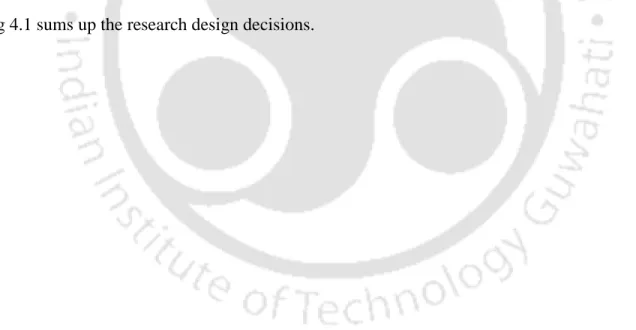
Test of Proposed Theoretical Models for Soldier’s Well- Being
- Introduction
- Research Questions
- Hypotheses
- Method
- Participants
- Measures Used for Data Collection
- Results
- Descriptive Statistics
- Exploratory Factor Analysis of All Scales
- Confirmatory Factor Analysis of all Scales: After the EFA results of all the nine scales were found to be acceptable, confirmatory factor analysis was carried out to further substantiate their
- Structural Equation Modeling (SEM)
- Path Analysis of Theoretical Models
- Results of the Protective Factors Model
- Results of the Moderated Path Model
- Summary of Hypotheses Testing Results
The sight of a dead body is horrifying to me." The true/false format is the original response option of the scale. Out of these, the TIPI presented a better solution for measuring personality in a limited assessment time (Vorkapic, 2016). The main contributions of using the TIPI in personality research is: a) it is the best solution in studies where brevity of the rating scale is a very high priority (Saucier, 1994); b) its use provides an accumulation of research results (Gosling, Rentfrow & Swann, 2003); and c) its item nonredundancy reduces boredom, frustration, and demotivation in participants in personality studies (Burisch, 1984).Model Fit Measures of the moderated path model (moderating effect of group involvement between social isolation and SWB).
Model Fit Measure of the moderated path model (moderating effect of resilience between death anxiety and SWB). Model Fit Measure of the moderated path model (moderating effect of leadership between death anxiety and SWB). Model Fit Measure of the moderated path model (moderating effect of group engagement between work-related stress and SWB).
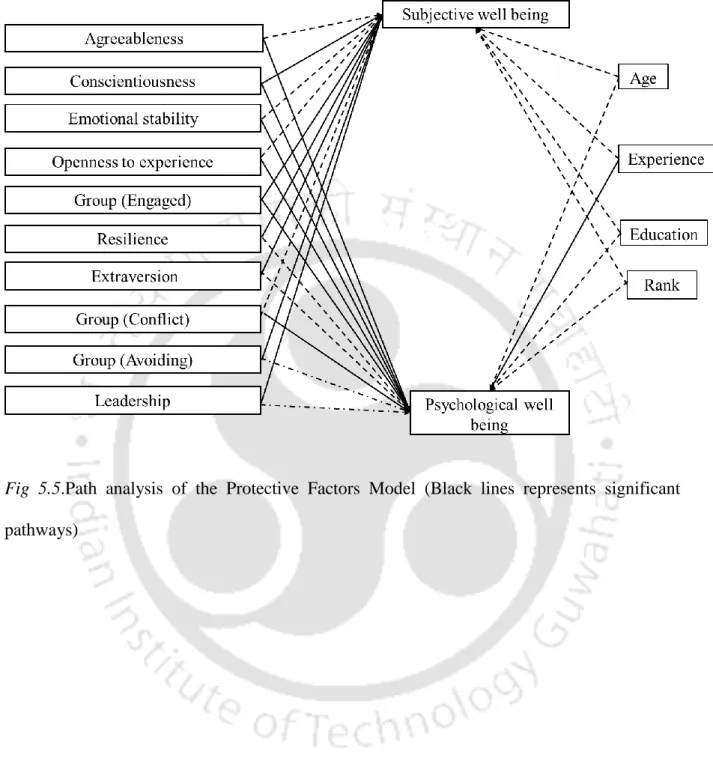
Discussion of Results
Development and validation of “Occupational Stress Scale for Soldiers”
OSSS)
Risk Factors for Indian Soldier’s Subjective and Psychological Well- being
Interestingly, the results of the analysis of our sample show that death anxiety has a significant negative relationship with SWB and a significant positive relationship with PWB among Indian soldiers. Therefore, it is likely that fear of death is a barrier to positive emotions and life satisfaction. Interestingly, however, for the current sample, death anxiety appears to have a positive impact on psychological well-being.
This contrasts with the results of many studies, such as a 2018 study by Varaee, Momeni & Moradi, which found that death anxiety had a negative effect on PWB in an older population.
Protective Factors for Indian Soldier’s Subjective and Psychological Well-being
As living conditions are constantly changing, such people are more likely to experience higher levels of psychological well-being (Ullah, 2017). A possible reason for this contradictory result in our study may be the fact that the military establishment does not encourage the expression of opinions and openness. When it comes to the effect of leadership on the level of well-being, we found in our analysis that there is a very high positive predictive relationship between leadership and its impact on soldiers' SWB.
The results make sense because leaders have a tremendous impact on soldiers and their lives due to the nature of a military job.
